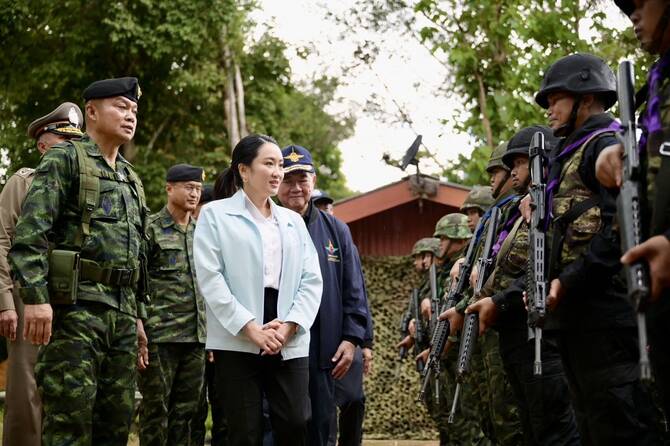BANGKOK: Thai Prime Minister Paetongtarn Shinawatra held make-up talks on Friday with an army commander she criticized in a leaked phone call as she struggled to defuse a crisis threatening to topple her government.
The daughter of controversial billionaire ex-PM Thaksin Shinawatra and in office for less than a year, Paetongtarn is facing calls to quit or announce an election as anger flares over the call with former Cambodian leader Hun Sen.
Her main coalition partner, the conservative Bhumjaithai party, pulled out on Wednesday, saying she had insulted the country and the army and leaving her government on the point of collapse.
She suffered another blow on Friday as reports emerged that another coalition partner was threatening to quit unless she stepped down as prime minister.
The crisis has sent the Thai stock market plunging to a five-year low and comes as the kingdom struggles to fire up its sluggish economy, with US President Donald Trump’s threatened trade tariffs looming.
Paetongtarn, 38, visited troops in northeast Thailand on Friday to patch things up with Lt. Gen. Boonsin Padklang after she was caught disparaging him as an “opponent” during the call with Hun Sen.
Boonsin commands Thai forces along the border with Cambodia, where a long-running dispute flared into deadly clashes last month, and Paetongtarn’s criticism of him drew accusations of disloyalty from right-wing nationalist critics.
Paetongtarn said after their meeting that the matter was settled.
“It went very well. I’ve spoken to the commander and there’s no longer any issue,” she told reporters.
For his part, Boonsin said “everything is normal.”
The meeting with Boonsin followed a public apology from Paetongtarn — at a news conference flanked by military and police chiefs — on Thursday as pressure on her mounted.
Paetongtarn was criticized as being weak and deferential in the call with Hun Sen, a veteran politician known as a wily operator, but her comments about the army commander were potentially the most damaging to her.
Thailand’s armed forces have long played a powerful role in the kingdom’s politics and politicians are usually careful not to antagonize them.
The apology and apparent reconciliation with the army commander may not be enough to save Paetongtarn’s premiership.
The departure of Bhumjaithai has left the government’s coalition with a razor-thin majority in parliament and losing another partner would likely see it collapse.
There was a glimmer of good news for Paetongtarn on Friday morning as the conservative Democrat Party pledged to stay in the coalition.
However, Public broadcaster ThaiPBS reported that the United Thai Nation (UTN) party, which has 36 seats and is now the biggest party in the coalition after Pheu Thai, is considering quitting.
The broadcaster said UTN was going to issue an ultimatum to Paetongtarn: either she quits as premier or they withdraw, bringing down the government.
There are also suggestions of a split within UTN, but the government’s majority is now so small that it could be fatal even if only half the party’s MPs leave.
Paetongtarn may also be facing the prospect of street protests, as political activists involved in huge demonstrations that helped sink previous leaders linked to her family called for her to go.
The activists have called for a rally in central Bangkok on Saturday and another on June 28, although it remains to be seen whether Paetongtarn will survive that long.
She took office in August last year at the head of an uneasy alliance between Pheu Thai and a group of conservative, pro-military parties whose members have spent much of the past 20 years battling against her father.
Thaksin, twice elected PM, was thrown out in a military coup in 2006 and the bitter tussle between the conservative, royalist establishment and the political movement he founded has dominated Thai politics throughout that time.
Hun Sen, Cambodia’s longtime ruler who stepped down in 2023 and had close ties with Thaksin, said on Friday that the row over the leaked call had “shattered” more than “30 years of heartfelt bonds between our two families.”














